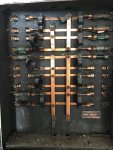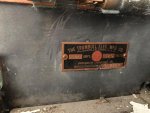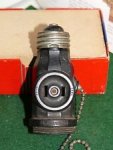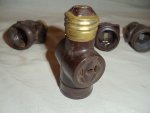You are using an out of date browser. It may not display this or other websites correctly.
You should upgrade or use an alternative browser.
You should upgrade or use an alternative browser.
Cool find..... I think around 1915
- Thread starter Vince1971
- Start date
- Status
- Not open for further replies.
K8MHZ
Senior Member
- Occupation
- Electrician
:thumbsup::thumbsup:
gadfly56
Senior Member
- Location
- New Jersey
- Occupation
- Professional Engineer, Fire & Life Safety
Are you just passing through that or actually doing work on it?
Coppersmith
Senior Member
- Location
- Tampa, FL, USA
- Occupation
- Electrical Contractor
Only 30 amps? Looks like it could handle more than that.
JFletcher
Senior Member
- Location
- Williamsburg, VA
Very cool. I am guessing that was not even made on an assembly line; the busbars do not intersect at perfect right angles.
The little rubber disconnect are in remarkable shape for being a hundred plus years old.
I'm sure the bus bars can, though the way they are connected to each other, and the feeder connections, 30 amps is probably it. With better connections or a one-piece buss it could probably handle a hundred amps.
The little rubber disconnect are in remarkable shape for being a hundred plus years old.
Only 30 amps? Looks like it could handle more than that.
I'm sure the bus bars can, though the way they are connected to each other, and the feeder connections, 30 amps is probably it. With better connections or a one-piece buss it could probably handle a hundred amps.
LarryFine
Master Electrician Electric Contractor Richmond VA
- Location
- Henrico County, VA
- Occupation
- Electrical Contractor
It does, but the rating probably stemmed from that being a standard residential service size, either one or two 30a circuits, especially back when homes weren't wired at all when they were built. I've worked in many homes like this in Church Hill in Richmond. Adding knob-and-tube wiring an existing house became an art back then.Only 30 amps? Looks like it could handle more than that.
The usual method to wire the first floor was, along the central wall in the upstairs hallway, to pry up two floorboards from the front of the house to the back, and brace-and-bit drill through every joist. That gave access to the downstairs ceiling lighting, the central wall both up and down for switches and receptacles, and 3-way switching in the hall.
The rest of the house was wired from the attic or the crawlspace. I've even seen houses where gas piping for both lighting and heat was added after the house was built. You can learn a lot about how a house was built by looking at exposed details when it has been gutted.
Added: By the way, that panel is a 120v panel, not 240v; they fused the neutral back then. And, with that many circuits, it likely was in a house that was wired with K&T when it was built.
Last edited:
JFletcher
Senior Member
- Location
- Williamsburg, VA
It does, but the rating probably stemmed from that being a standard residential service size, either one or two 30a circuits, especially back when homes weren't wired at all when they were built. I've worked in many homes like this in Church Hill in Richmond. Adding knob-and-tube wiring an existing house became an art back then.
The usual method to wire the first floor was, along the central wall in the upstairs hallway, to pry up two floorboards from the front of the house to the back, and brace-and-bit drill through every joist. That gave access to the downstairs ceiling lighting, the central wall both up and down for switches and receptacles, and 3-way switching in the hall.
The rest of the house was wired from the attic or the crawlspace. I've even seen houses where gas piping for both lighting and heat was added after the house was built. You can learn a lot about how a house was built by looking at exposed details when it has been gutted.
Added: By the way, that panel is a 120v panel, not 240v; they fused the neutral back then. And, with that many circuits, it likely was in a house that was wired with K&T when it was built.
Also very cool to learn. I have never worked with knob and tube, about the oldest I see is the old armored BX cable, maybe remnants of an old k&t system... Old porcelain insulators in the attic.
The other thing that I noticed about the panel is its utter lack of anything resembling a safety feature, save for the insulated disconnects. Closing the disconnect, or installing with fuse, on a bolted fault with the dead front off and absolutely nothing in the way of you and the ensuing arc...yikes! No PPE, I guess it would have been more prudent than ever to check the circuit integrity before you closed the circuit in the panel.
Could that panel have also been used with a DC circuit? It is not labeled AC or DC, though I presume from the voltage it would have been AC.
LarryFine
Master Electrician Electric Contractor Richmond VA
- Location
- Henrico County, VA
- Occupation
- Electrical Contractor
gadfly56
Senior Member
- Location
- New Jersey
- Occupation
- Professional Engineer, Fire & Life Safety
99% sure it was AC.
It's amazing how rare shorts occurred in K&T-wired homes, because the wires are a foot or more apart in most places.
Overloads, yes, especially with the invention of these, as the first wired homes had only pendant lighting in each room:
View attachment 21796 View attachment 21797
My last house was built in the late '20's, and that is the only way I had electricity for any purpose other than lighting in the upstairs area.
kwired
Electron manager
- Location
- NE Nebraska
But also consider that available fault current levels back then were probably nothing like they may be today. Still some hazard but incident energy level was overall lower than it will often be today.Also very cool to learn. I have never worked with knob and tube, about the oldest I see is the old armored BX cable, maybe remnants of an old k&t system... Old porcelain insulators in the attic.
The other thing that I noticed about the panel is its utter lack of anything resembling a safety feature, save for the insulated disconnects. Closing the disconnect, or installing with fuse, on a bolted fault with the dead front off and absolutely nothing in the way of you and the ensuing arc...yikes! No PPE, I guess it would have been more prudent than ever to check the circuit integrity before you closed the circuit in the panel.
Could that panel have also been used with a DC circuit? It is not labeled AC or DC, though I presume from the voltage it would have been AC.
drcampbell
Senior Member
- Location
- The Motor City, Michigan USA
- Occupation
- Registered Professional Engineer
The other thing that strikes me is the large number of circuits and the low current rating. 30 amps, ten circuits?
Then again, I have encountered 16 AWG lighting circuits in buildings of that same era.
I thought "dead front" referred to design elements that enable you to turn a circuit on & off, change fuses or reset breakers without any risk of touching anything energized?
It doesn't say "AC only", so installing it in a DC system wouldn't have been a listing violation. (if there even were "listing violations" in 1915) I'm not sure when we began to understand that equipment wasn't generally suitable for the same DC and AC voltage.
This device also contributed to a lot of overloads and fires:
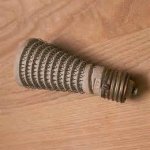
Then again, I have encountered 16 AWG lighting circuits in buildings of that same era.
Even a fuse not labeled "current limiting" will provide some current limiting into a bolted fault.... The other thing that I noticed about the panel is its utter lack of anything resembling a safety feature, save for the insulated disconnects. Closing the disconnect, or installing with fuse, on a bolted fault with the dead front off and absolutely nothing in the way of you and the ensuing arc...yikes! No PPE, I guess it would have been more prudent than ever to check the circuit integrity before you closed the circuit in the panel.
Could that panel have also been used with a DC circuit? It is not labeled AC or DC, though I presume from the voltage it would have been AC.
I thought "dead front" referred to design elements that enable you to turn a circuit on & off, change fuses or reset breakers without any risk of touching anything energized?
It doesn't say "AC only", so installing it in a DC system wouldn't have been a listing violation. (if there even were "listing violations" in 1915) I'm not sure when we began to understand that equipment wasn't generally suitable for the same DC and AC voltage.
This device also contributed to a lot of overloads and fires:

- Status
- Not open for further replies.


